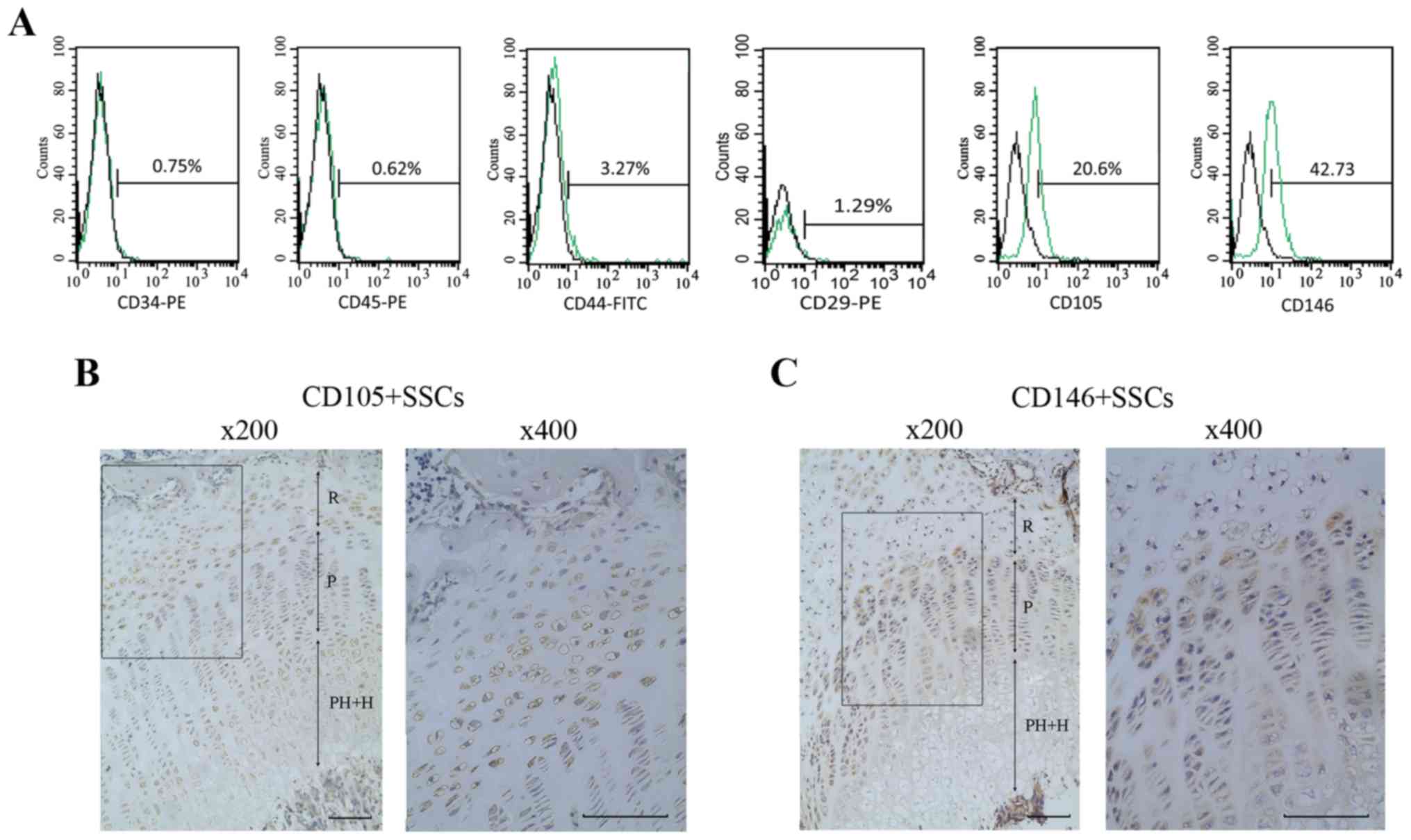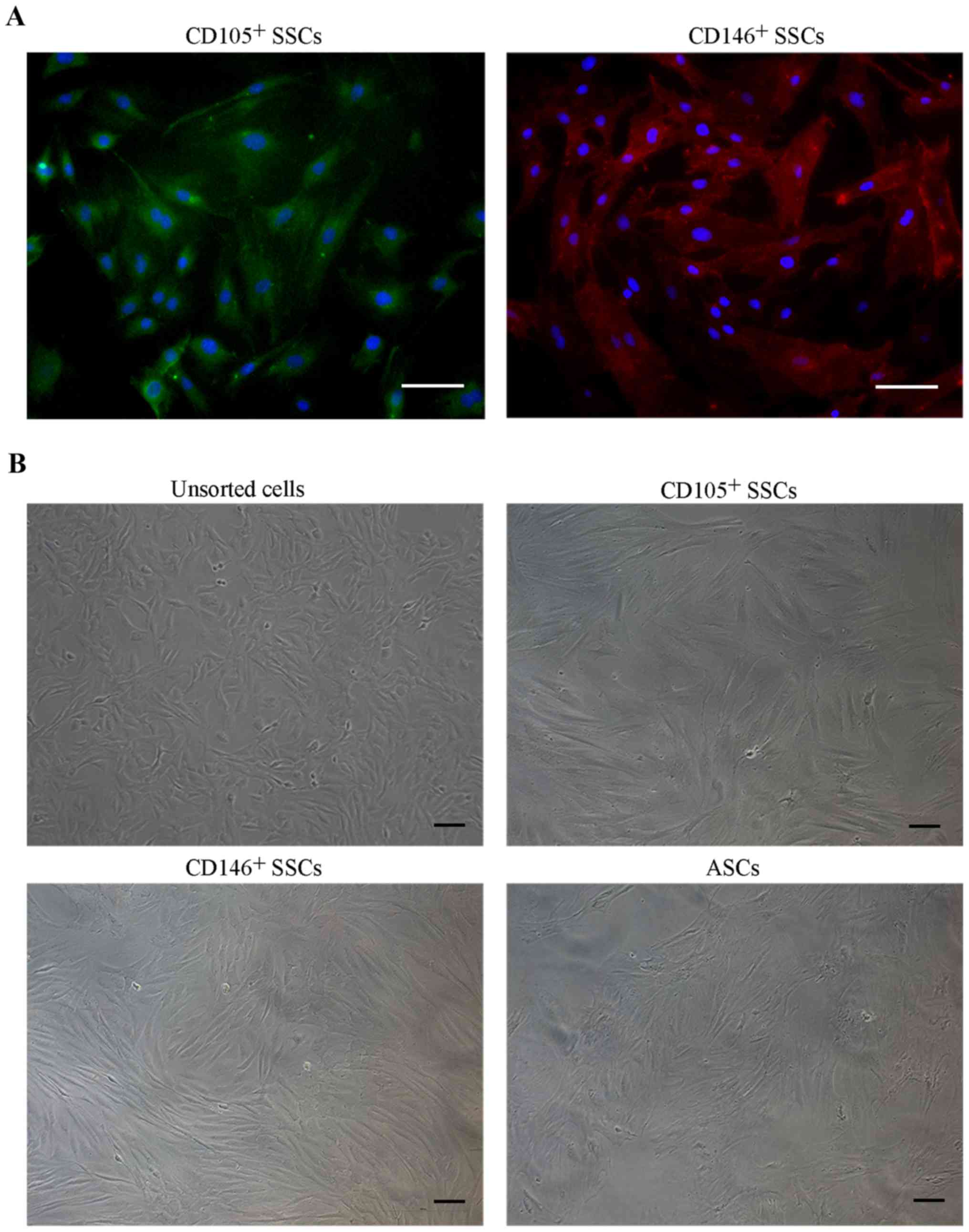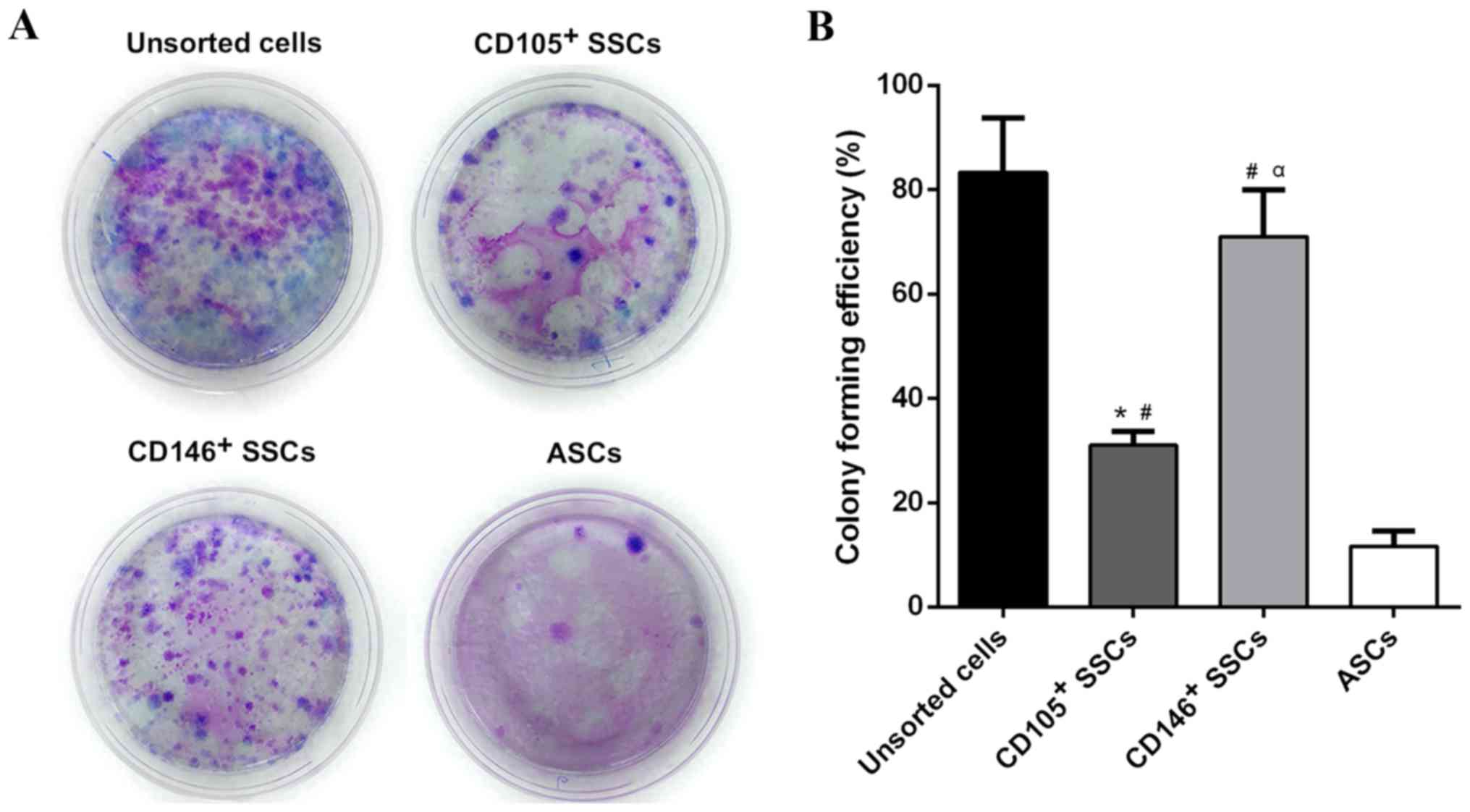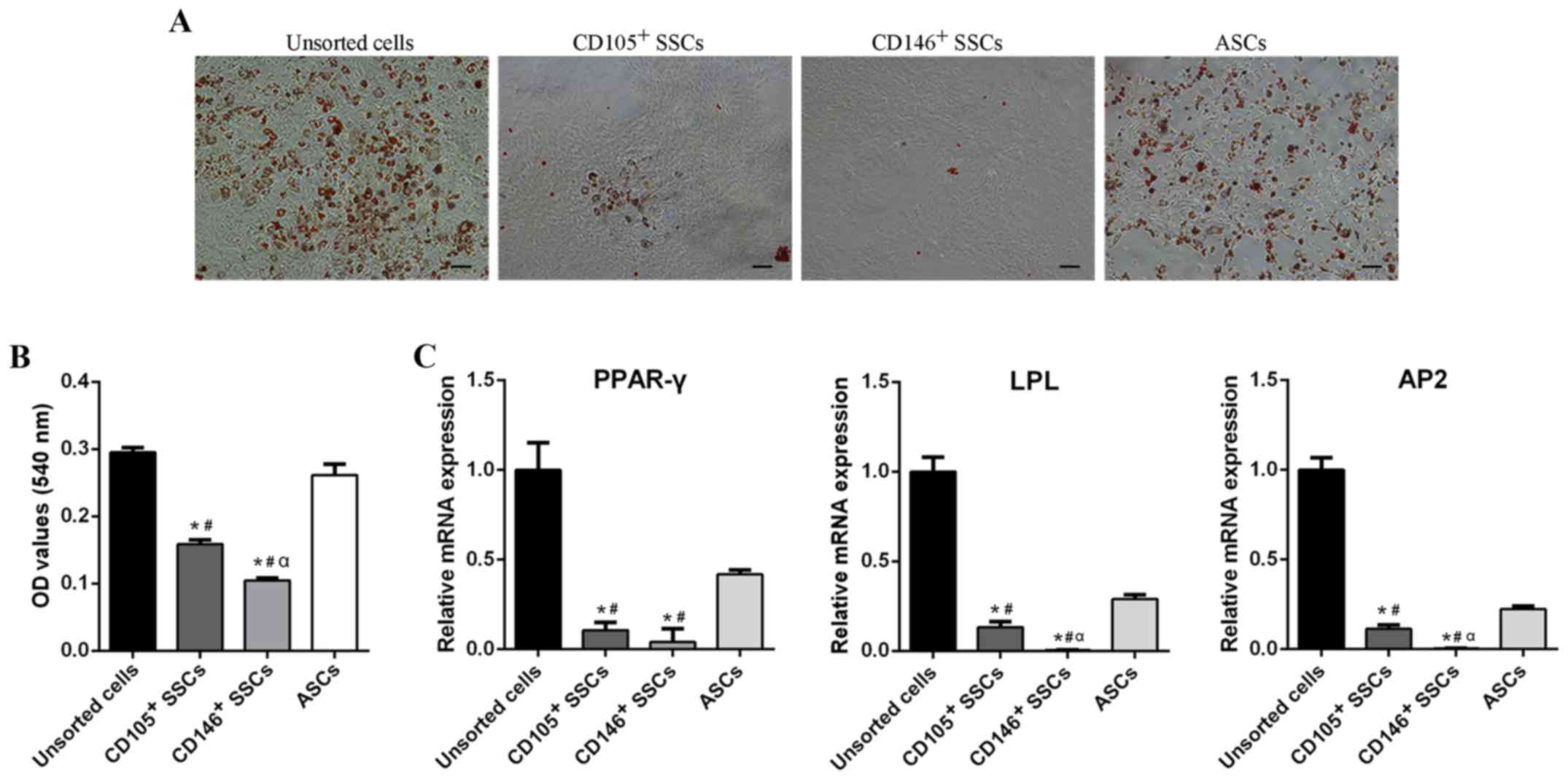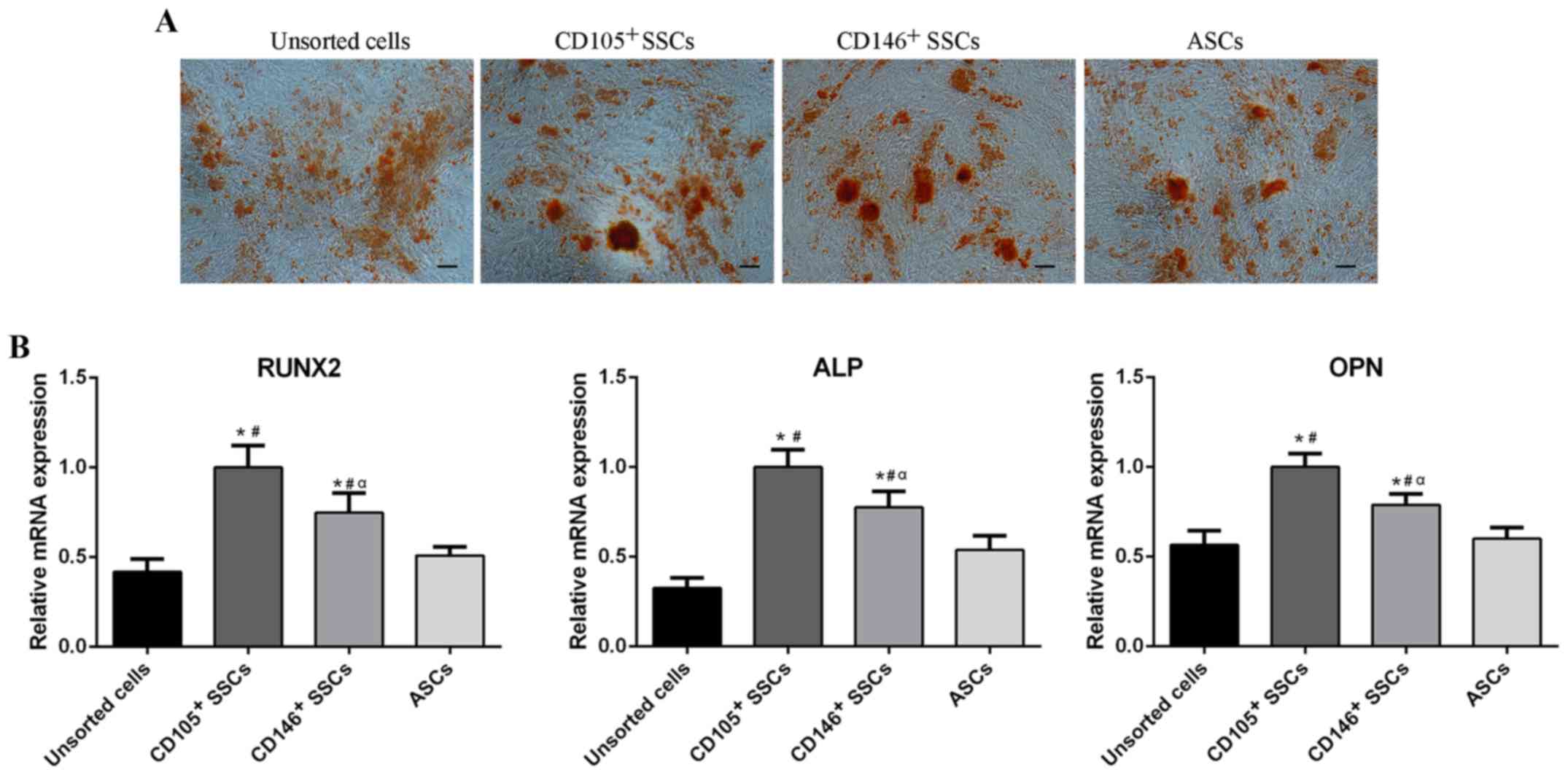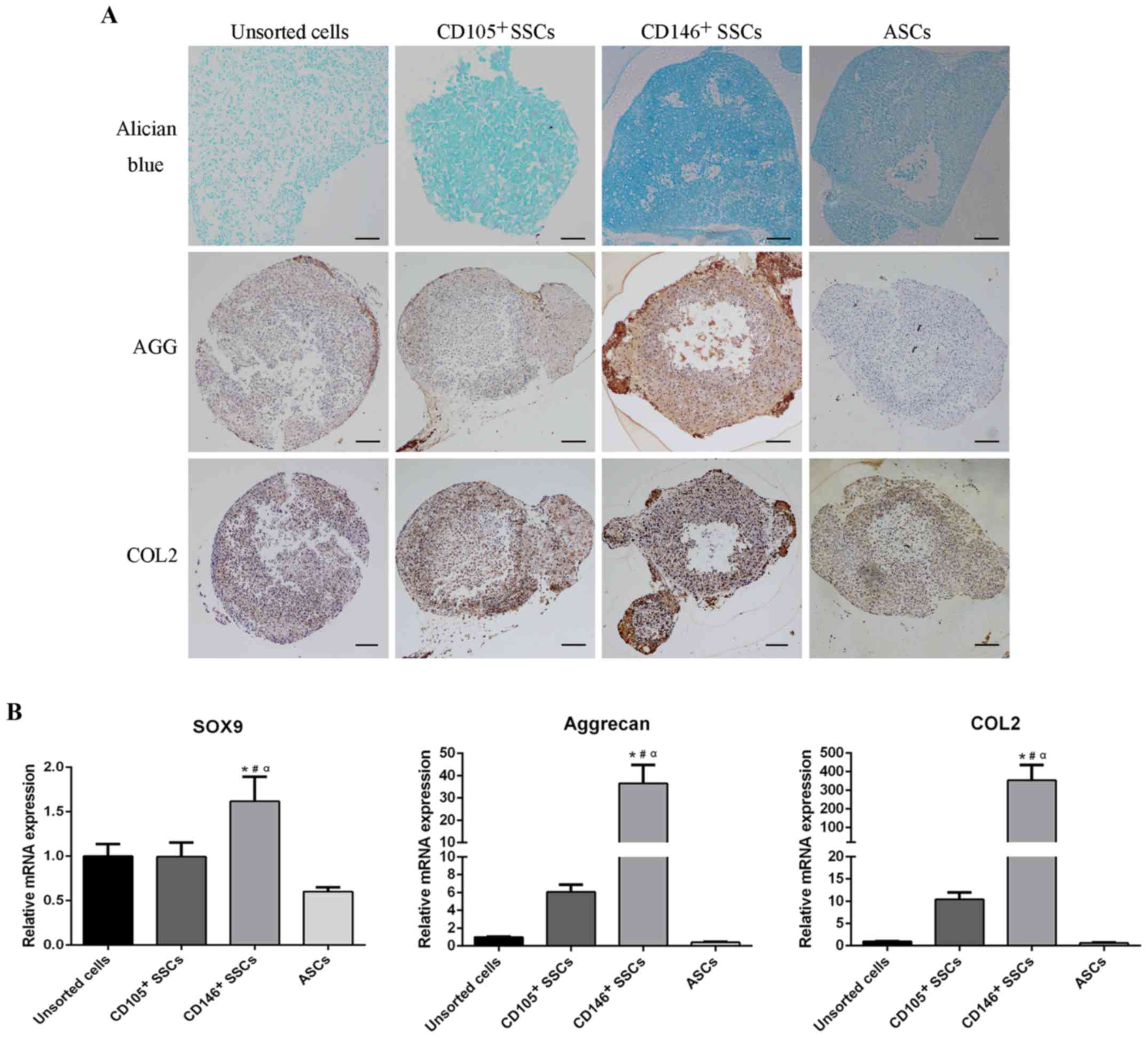|
1
|
Blunk T, Sieminski AL, Gooch KJ, Courter
DL, Hollander AP, Nahir AM, Langer R, Vunjak-Novakovic G and Freed
LE: Differential effects of growth factors on tissue-engineered
cartilage. Tissue Eng. 8:73–84. 2002. View Article : Google Scholar : PubMed/NCBI
|
|
2
|
Ishimura D, Yamamoto N, Tajima K, Ohno A,
Yamamoto Y, Washimi O and Yamada H: Differentiation of
adipose-derived stromal vascular fraction culture cells into
chondrocytes using the method of cell sorting with a mesenchymal
stem cell marker. Tohoku J Exp Med. 216:149–156. 2008. View Article : Google Scholar : PubMed/NCBI
|
|
3
|
Jo CH, Lee YG, Shin WH, Kim H, Chai JW,
Jeong EC, Kim JE, Shim H, Shin JS, Shin IS, et al: Intra-articular
injection of mesenchymal stem cells for the treatment of
osteoarthritis of the knee: A proof-of-concept clinical trial. Stem
cells. 32:1254–1266. 2014. View Article : Google Scholar : PubMed/NCBI
|
|
4
|
Jiang T, Liu W, Lv X, Sun H, Zhang L, Liu
Y, Zhang WJ, Cao Y and Zhou G: Potent in vitro chondrogenesis of
CD105 enriched human adipose-derived stem cells. Biomaterials.
31:3564–3571. 2010. View Article : Google Scholar : PubMed/NCBI
|
|
5
|
Kobayashi S, Takebe T, Inui M, Iwai S, Kan
H, Zheng YW, Maegawa J and Taniguchi H: Reconstruction of human
elastic cartilage by a CD44+ CD90+ stem cell
in the ear perichondrium. Proc Natl Acad Sci USA. 108:pp.
14479–14484. 2011; View Article : Google Scholar : PubMed/NCBI
|
|
6
|
Crisan M, Yap S, Casteilla L, Chen CW,
Corselli M, Park TS, Andriolo G, Sun B, Zheng B, Zhang L, et al: A
perivascular origin for mesenchymal stem cells in multiple human
organs. Cell Stem Cell. 3:301–313. 2008. View Article : Google Scholar : PubMed/NCBI
|
|
7
|
Bhumiratana S, Eton RE, Oungoulian SR, Wan
LQ, Ateshian GA and Vunjak-Novakovic G: Large, stratified, and
mechanically functional human cartilage grown in vitro by
mesenchymal condensation. Proc Natl Acad Sci USA. 111:pp.
6940–6945. 2014; View Article : Google Scholar : PubMed/NCBI
|
|
8
|
Oldershaw RA: Cell sources for the
regeneration of articular cartilage: The past, the horizon and the
future. Int J Exp Pathol. 93:389–400. 2012.PubMed/NCBI
|
|
9
|
Belluoccio D, Bernardo BC, Rowley L and
Bateman JF: A microarray approach for comparative expression
profiling of the discrete maturation zones of mouse growth plate
cartilage. Biochim Biophys Acta. 1779:330–340. 2008. View Article : Google Scholar : PubMed/NCBI
|
|
10
|
Pichler K, Schmidt B, Fischerauer EE,
Rinner B, Dohr G, Leithner A and Weinberg AM: Behaviour of human
physeal chondro-progenitorcells in early growth plate injury
response in vitro. Int Orthop. 36:1961–1966. 2012. View Article : Google Scholar : PubMed/NCBI
|
|
11
|
Gothard D, Cheung K, Kanczler JM, Wilson
DI and Oreffo RO: Regionally-derived cell populations and skeletal
stem cells from human foetal femora exhibit specific osteochondral
and multi-lineage differentiation capacity in vitro and ex vivo.
Stem Cell Res Ther. 6:2512015. View Article : Google Scholar : PubMed/NCBI
|
|
12
|
Chan CK, Seo EY, Chen JY, Lo D, McArdle A,
Sinha R, Tevlin R, Seita J, Vincent-Tompkins J, Wearda T, et al:
Identification and specification of the mouse skeletal stem cell.
Cell. 160:285–298. 2015. View Article : Google Scholar : PubMed/NCBI
|
|
13
|
Worthley DL, Churchill M, Compton JT,
Tailor Y, Rao M, Si Y, Levin D, Schwartz MG, Uygur A, Hayakawa Y,
et al: Gremlin 1 identifies a skeletal stem cell with bone,
cartilage and reticular stromal potential. Cell. 160:269–284. 2015.
View Article : Google Scholar : PubMed/NCBI
|
|
14
|
Chan CK, Lindau P, Jiang W, Chen JY, Zhang
LF, Chen CC, Seita J, Sahoo D, Kim JB, Lee A, et al: Clonal
precursor of bone, cartilage, and hematopoietic niche stromal
cells. Proc Natl Acad Sci USA. 110:pp. 12643–12648. 2013;
View Article : Google Scholar : PubMed/NCBI
|
|
15
|
Chiba H, Ishii G, Ito TK, Aoyagi K, Sasaki
H, Nagai K and Ochiai A: CD105-positive cells in pulmonary arterial
blood of adult human lung cancer patients include mesenchymal
progenitors. Stem cells. 26:2523–2530. 2008. View Article : Google Scholar : PubMed/NCBI
|
|
16
|
Salamon A, Jonitz-Heincke A, Adam S,
Rychly J, Müller-Hilke B, Bader R, Lochner K and Peters K:
Articular cartilage-derived cells hold a strong osteogenic
differentiation potential in comparison to mesenchymal stem cells
in vitro. Exp Cell Res. 319:2856–2865. 2013. View Article : Google Scholar : PubMed/NCBI
|
|
17
|
Amiri F, Halabian R, Harati M Dehgan,
Bahadori M, Mehdipour A, Roushandeh A Mohammadi and Roudkenar M
Habibi: Positive selection of Wharton's jelly-derived CD105(+)
cells by MACS technique and their subsequent cultivation under
suspension culture condition: A simple, versatile culturing method
to enhance the multipotentiality of mesenchymal stem cells.
Hematology. 20:208–216. 2015. View Article : Google Scholar : PubMed/NCBI
|
|
18
|
Odabas S, Sayar F, Güven G,
Yanikkaya-Demirel G and Pişkin E: Separation of mesenchymal stem
cells with magnetic nanosorbents carrying CD105 and CD73 antibodies
in flow-through and batch systems. J Chromatogr B Analyt Technol
Biomed Life Sci. 861:74–80. 2008. View Article : Google Scholar : PubMed/NCBI
|
|
19
|
Qi J, Chen A, You H, Li K, Zhang D and Guo
F: Proliferation and chondrogenic differentiation of CD105-positive
enriched rat synovium-derived mesenchymal stem cells in
three-dimensional porous scaffolds. Biomed Mater. 6:0150062011.
View Article : Google Scholar : PubMed/NCBI
|
|
20
|
Chan CK, Chen CC, Luppen CA, Kim JB,
DeBoer AT, Wei K, Helms JA, Kuo CJ, Kraft DL and Weissman IL:
Endochondral ossification is required for haematopoietic stem-cell
niche formation. Nature. 457:490–494. 2009. View Article : Google Scholar : PubMed/NCBI
|
|
21
|
Gothard D, Greenhough J, Ralph E and
Oreffo RO: Prospective isolation of human bone marrow stromal cell
subsets: A comparative study between Stro-1-, CD146- and
CD105-enriched populations. J Tissue Eng. 5:20417314145517632014.
View Article : Google Scholar : PubMed/NCBI
|
|
22
|
Bakopoulou A, Leyhausen G, Volk J, Koidis
P and Geurtsen W: Comparative characterization of
STRO-1(neg)/CD146(pos) and STRO-1(pos)/CD146(pos) apical papilla
stem cells enriched with flow cytometry. Arch Oral Biol.
58:1556–1568. 2013. View Article : Google Scholar : PubMed/NCBI
|
|
23
|
Middleton J, Americh L, Gayon R, Julien D,
Mansat M, Mansat P, Anract P, Cantagrel A, Cattan P, Reimund JM, et
al: A comparative study of endothelial cell markers expressed in
chronically inflamed human tissues: MECA-79, Duffy antigen receptor
for chemokines, von Willebrand factor, CD31, CD34, CD105 and CD146.
J Pathol. 206:260–268. 2005. View Article : Google Scholar : PubMed/NCBI
|
|
24
|
Schugar RC, Chirieleison SM, Wescoe KE,
Schmidt BT, Askew Y, Nance JJ, Evron JM, Peault B and Deasy BM:
High harvest yield, high expansion, and phenotype stability of
CD146 mesenchymal stromal cells from whole primitive human
umbilical cord tissue. J Biomed Biotechnol. 2009:7895262009.
View Article : Google Scholar : PubMed/NCBI
|
|
25
|
Tsang WP, Shu Y, Kwok PL, Zhang F, Lee KK,
Tang MK, Li G, Chan KM, Chan WY and Wan C: CD146+ human
umbilical cord perivascular cells maintain stemness under hypoxia
and as a cell source for skeletal regeneration. PLoS One.
8:e761532013. View Article : Google Scholar : PubMed/NCBI
|
|
26
|
Wu CC, Liu FL, Sytwu HK, Tsai CY and Chang
DM: CD146+ mesenchymal stem cells display greater
therapeutic potential than CD146-cells for treating
collagen-induced arthritis in mice. Stem Cell Res Ther. 7:232016.
View Article : Google Scholar : PubMed/NCBI
|
|
27
|
Jiang Y, Cai Y, Zhang W, Yin Z, Hu C, Tong
T, Lu P, Zhang S, Neculai D, Tuan RS and Ouyang HW: Human
cartilage-derived progenitor cells from committed chondrocytes for
efficient cartilage repair and regeneration. Stem Cells Transl Med.
5:733–744. 2016. View Article : Google Scholar : PubMed/NCBI
|
|
28
|
Wong HL, Siu WS, Fung CH, Zhang C, Shum
WT, Zhou XL, Lau CB, Zhang JF, Leung PC, Fu WM and Ko CH:
Characteristics of stem cells derived from rat fascia: In vitro
proliferative and multilineage potential assessment. Mol Med Rep.
11:1982–1990. 2015. View Article : Google Scholar : PubMed/NCBI
|
|
29
|
Qi Y, Du Y, Li W, Dai X, Zhao T and Yan W:
Cartilage repair using mesenchymal stem cell (MSC) sheet and
MSCs-loaded bilayer PLGA scaffold in a rabbit model. Knee Surg
Sports Traumatol Arthrosc. 22:1424–1433. 2014. View Article : Google Scholar : PubMed/NCBI
|
|
30
|
Villemure I and Stokes IA: Growth plate
mechanics and mechanobiology. A survey of present understanding. J
Biomech. 42:1793–1803. 2009. View Article : Google Scholar : PubMed/NCBI
|
|
31
|
Lui JC, Nilsson O and Baron J: Recent
research on the growth plate: Recent insights into the regulation
of the growth plate. J Mol Endocrinol. 53:T1–T9. 2014. View Article : Google Scholar : PubMed/NCBI
|
|
32
|
Chagin AS and Kronenberg HM: Role of
G-proteins in the differentiation of epiphyseal chondrocytes. J Mol
Endocrinol. 53:R39–R45. 2014. View Article : Google Scholar : PubMed/NCBI
|
|
33
|
Belluoccio D, Etich J, Rosenbaum S, Frie
C, Grskovic I, Stermann J, Ehlen H, Vogel S, Zaucke F, von der Mark
K, et al: Sorting of growth plate chondrocytes allows the isolation
and characterization of cells of a defined differentiation status.
J Bone Miner Res. 25:1267–1281. 2010. View Article : Google Scholar : PubMed/NCBI
|
|
34
|
Xu J, Wang W, Kapila Y, Lotz J and Kapila
S: Multiple differentiation capacity of
STRO-1+/CD146+ PDL mesenchymal progenitor
cells. Stem Cells Dev. 18:487–496. 2009. View Article : Google Scholar : PubMed/NCBI
|
|
35
|
Su X, Zuo W, Wu Z, Chen J, Wu N, Ma P, Xia
Z, Jiang C, Ye Z, Liu S, et al: CD146 as a new marker for an
increased chondroprogenitor cell sub-population in the later stages
of osteoarthritis. J Orthop Res. 33:84–91. 2015. View Article : Google Scholar : PubMed/NCBI
|
|
36
|
Wang Z and Yan X: CD146, a
multi-functional molecule beyond adhesion. Cancer Lett.
330:150–162. 2013. View Article : Google Scholar : PubMed/NCBI
|
|
37
|
Guezguez B, Vigneron P, Lamerant N, Kieda
C, Jaffredo T and Dunon D: Dual role of melanoma cell adhesion
molecule (MCAM)/CD146 in lymphocyte endothelium interaction:
MCAM/CD146 promotes rolling via microvilli induction in lymphocyte
and is an endothelial adhesion receptor. J Immunol. 179:6673–6685.
2007. View Article : Google Scholar : PubMed/NCBI
|
|
38
|
Jin HJ, Kwon JH, Kim M, Bae YK, Choi SJ,
Oh W, Yang YS and Jeon HB: Downregulation of melanoma cell adhesion
molecule (MCAM/CD146) accelerates cellular senescence in human
umbilical cord blood-derived mesenchymal stem cells. Stem Cells
Transl Med. 5:427–439. 2016. View Article : Google Scholar : PubMed/NCBI
|
|
39
|
Qian YN, Luo YT, Duan HX, Feng LQ, Bi Q,
Wang YJ and Yan XY: Adhesion molecule CD146 and its soluble form
correlate well with carotid atherosclerosis and plaque instability.
CNS Neurosci Ther. 20:438–445. 2014. View Article : Google Scholar : PubMed/NCBI
|
|
40
|
Bu P, Zhuang J, Feng J, Yang D, Shen X and
Yan X: Visualization of CD146 dimerization and its regulation in
living cells. Biochim Biophys Acta. 1773:513–520. 2007. View Article : Google Scholar : PubMed/NCBI
|
|
41
|
Sorrentino A, Ferracin M, Castelli G,
Biffoni M, Tomaselli G, Baiocchi M, Fatica A, Negrini M, Peschle C
and Valtieri M: Isolation and characterization of CD146+
multipotent mesenchymal stromal cells. Exp Hematol. 36:1035–1046.
2008. View Article : Google Scholar : PubMed/NCBI
|
|
42
|
Balakumaran A, Mishra PJ, Pawelczyk E,
Yoshizawa S, Sworder BJ, Cherman N, Kuznetsov SA, Bianco P, Giri N,
Savage SA, et al: Bone marrow skeletal stem/progenitor cell defects
in dyskeratosis congenita and telomere biology disorders. Blood.
125:793–802. 2015. View Article : Google Scholar : PubMed/NCBI
|
|
43
|
Dawson JI, Kanczler J, Tare R, Kassem M
and Oreffo RO: Concise review: Bridging the gap: Bone regeneration
using skeletal stem cell-based strategies-where are we now? Stem
cells. 32:35–44. 2014. View Article : Google Scholar : PubMed/NCBI
|
|
44
|
Agarwal S, Loder SJ, Sorkin M, Li S,
Shrestha S, Zhao B, Mishina Y, James AW and Levi B: Analysis of
bone-cartilage-stromal progenitor populations in trauma induced and
genetic models of heterotopic ossification. Stem cells.
34:1692–1701. 2016. View Article : Google Scholar : PubMed/NCBI
|
|
45
|
Aslan H, Zilberman Y, Kandel L, Liebergall
M, Oskouian RJ, Gazit D and Gazit Z: Osteogenic differentiation of
noncultured immunoisolated bone marrow-derived CD105+
cells. Stem cells. 24:1728–1737. 2006. View Article : Google Scholar : PubMed/NCBI
|
|
46
|
Aicher WK, Bühring HJ, Hart M, Rolauffs B,
Badke A and Klein G: Regeneration of cartilage and bone by defined
subsets of mesenchymal stromal cells-potential and pitfalls. Adv
Drug Deliv Rev. 63:342–351. 2011. View Article : Google Scholar : PubMed/NCBI
|
|
47
|
Wang L, Shao YY and Ballock RT: Peroxisome
proliferator-activated receptor-gamma promotes adipogenic changes
in growth plate chondrocytes in vitro. PPAR Res. 2006:672972006.
View Article : Google Scholar : PubMed/NCBI
|
|
48
|
Ferrer-Lorente R, Bejar MT, Tous M,
Vilahur G and Badimon L: Systems biology approach to identify
alterations in the stem cell reservoir of subcutaneous adipose
tissue in a rat model of diabetes: Effects on differentiation
potential and function. Diabetologia. 57:246–256. 2014. View Article : Google Scholar : PubMed/NCBI
|
|
49
|
Ma T, Liu H, Chen W, Xia X, Bai X, Liang
L, Zhang Y and Liang T: Implanted adipose-derived stem cells
attenuate small-for-size liver graft injury by secretion of VEGF in
rats. Am J Transplant. 12:620–629. 2012. View Article : Google Scholar : PubMed/NCBI
|
|
50
|
Erdman CP, Dosier CR, Olivares-Navarrete
R, Baile C, Guldberg RE, Schwartz Z and Boyan BD: Effects of
resveratrol on enrichment of adipose-derived stem cells and their
differentiation to osteoblasts in two-and three-dimensional
cultures. J Tissue Eng Regen Med. 6 Suppl 3:S34–S46. 2012.
View Article : Google Scholar : PubMed/NCBI
|
|
51
|
Ye Y, Du Y, Guo F, Gong C, Yang K and Qin
L: Comparative study of the osteogenic differentiation capacity of
human bone marrow- and human adipose-derived stem cells under
cyclic tensile stretch using quantitative analysis. Int J Mol Med.
30:1327–1334. 2012. View Article : Google Scholar : PubMed/NCBI
|
|
52
|
Quarto N, Senarath-Yapa K, Renda A and
Longaker MT: TWIST1 silencing enhances in vitro and in vivo
osteogenic differentiation of human adipose-derived stem cells by
triggering activation of BMP-ERK/FGF signaling and TAZ
upregulation. Stem cells. 33:833–847. 2015. View Article : Google Scholar : PubMed/NCBI
|
|
53
|
Hamid AA, Idrus RB, Saim AB, Sathappan S
and Chua KH: Characterization of human adipose-derived stem cells
and expression of chondrogenic genes during induction of cartilage
differentiation. Clinics (Sao Paulo). 67:99–106. 2012. View Article : Google Scholar : PubMed/NCBI
|



